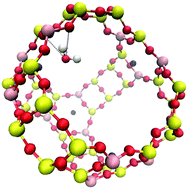Shared hydrogen bonds: water in aluminated faujasite
Abstract
Water confined in faujasite, a zeolite, with aluminium content, exhibits properties different from those of bulk water as well as water confined in siliceous faujasite. The RDF between oxygen of water (OW) and oxygen of aluminium (OAl) shows a prominent first peak near to 2.9 Å similar to any oxygen–oxygen RDF seen in bulk water and unlike water confined in siliceous faujasite. Further, HW–OAl shows a peak near 1.9 Å suggesting hydrogen bonding between hydrogen of water and OAl. The water satisfies the hydrogen bond criteria with both O1Al and O2Al indicating that it is participating in a shared hydrogen bond. The hydrogen bond exchange between such a water forming a shared hydrogen bond to OAl and another water molecule H2Ob is investigated through the changes in the distances and appropriate angles. The O–Al–O angle of the zeolite increases by about 7 degrees on the formation of the shared hydrogen bond. The jump dynamics of the shared hydrogen bond when the two bonds break simultaneously has been obtained and this is reported. This jump reorientation dynamics is different compared to normal hydrogen bonding reported by Laage and Hynes: it has a short lifetime, around 50–100 fs computed from SHB(t). The intermittent and continuous hydrogen bond correlation functions are also reported.



 Please wait while we load your content...
Please wait while we load your content...